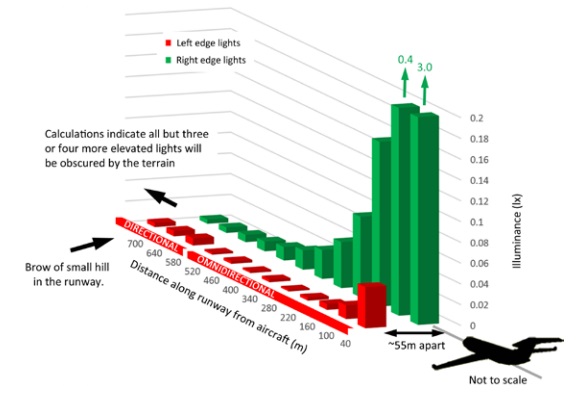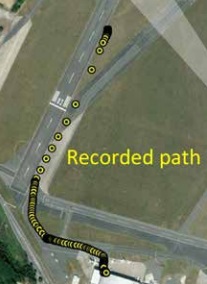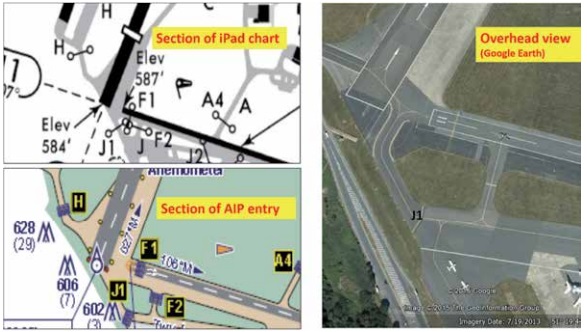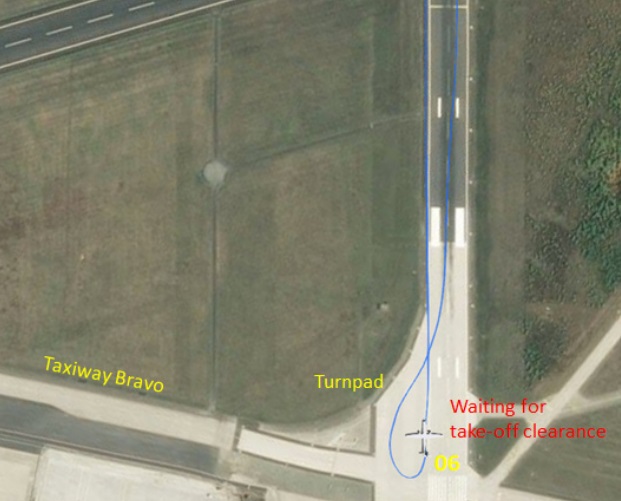Gulfstream III Attempted Takeoff Using Runway Edge Lights as Centerline
The UK Air Accidents Investigation Branch (AAIB) has recently reported on an attempted Gulfstream G-III business jet take off at Biggin Hill Airport where:
The aircraft lined up for takeoff in conditions of reduced visibility [at 20:28 local time]. The crew believed that the lights they could see ahead were runway centreline lights when they were actually runway edge lights [though this runway had no centreline lights].
The aircraft began its takeoff run but ran off the paved surface and onto grass. The commander closed the thrust levers to reject the takeoff.
The incident involved US registered G-III (G-1159A) N103CD on 24 November 2014, departing on a private flight to Gander, Canada. The crew of 2 and the 5 passengers were unharmed. The aircraft was assessed as being beyond economic repair. The nose landing gear broke off and tore a 6.5 m long hole on the fuselage skin. A number of frames were damaged and the upper fuselage skin creased and ruptured.
Investigation
Visibility was not in practice as good as the crew thought:
This was a private flight which could not depart in conditions of less than 400 m [Runway Visual Range] RVR. RVR cannot be measured at the threshold end of Runway 03 but the prevailing visibility was reported as being more than 10 km.
The crew reported that there was moisture on the windscreen from the mist and they could see a “glow” around lights which were visible to them. They were also aware while taxiing that there was some patchy ground fog on the airfield. The ATC controller transmitted that visibility had not been measured in the fog patches but there seemed to be ‘very low, very thin fog from the zero three threshold to approximately half way down the runway’.
With hindsight, this piece of information is significant but, at the time, the crew did not consider the fog to be widespread or thick; operating under FAR Part 91 in the United States, they were used to making their own judgments as to whether the visibility was suitable for a takeoff.
However, after the aircraft came to a halt following its abortive takeoff attempt, the controller could only see the top of the fuselage and tail above the layer of fog. It is likely, therefore, that the visibility was worse than the crew appreciated at the time N103CD taxied from Holding Point J1.
Biggin Hill was originally a Royal Air Force (RAF) station. At the beginning of Runway 03 there is a former RAF Operational Readiness Platform (ORP).
The aerodrome chart used by the crew was contained in an iPad app which was updated through a subscription service with the product supplier. [That] and the source of information in the UK [Aeronautical Information Publication] AIP, suggested that the aircraft would be required to taxi in a straight line from J1 to the runway and then make a right turn onto the runway heading.
In fact, in order to taxi from J1 onto the runway, an aircraft must: taxi in a straight line; follow a curve to the right onto runway heading but still displaced to the right of the runway itself; turn left towards the runway; and then turn right again onto runway heading.
The UK AIP states that there is no centreline lighting on Runway 03, and that the pavement width at the beginning of the runway is twice the normal runway width. It recognises the potential for confusion and urges crews to ensure that they have lined up correctly.
This information was not available to the crew on their aerodrome charts and both crew members believed that the runway had centreline lighting.
The AAIB also note that:
Pilots had previously reported having difficulty when vacating the runway near the Runway 03 threshold because of a lack of taxiway lighting.
Once lined up on the right hand lights, assuming the lights are at minimum spec and visibility is 1 km, a study done for AAIB highlights the much greater intensity of the right hand lights to the crew.

Illustration of light intensity of a combined omnidirectional and
bi-directional runway edge light, assuming optimal vertical viewing angle
and 1 km visibility (Credit: AAIB)
In 2009-2010 the Australian Transport Safety Bureau (ATSB) produced a report, ‘Factors influencing misaligned take-off occurrences at night‘. The AAIB highlight that five of the factors identified by that ATSB report were present in this accident:
- It was dark.
- It was potentially a confusing taxiway environment given that the aerodrome chart did not reflect the actual layout of the taxiways.
- There was an additional paved area (the ORP) near the runway.
- There was no runway centreline lighting and the runway edge lights before the displaced threshold were recessed.
- There was reduced visibility.
Safety Actions
The airport’s SMS had identified a need to enhance the lighting in the area surrounding the Runway 03 threshold. This required major ground works and construction of a sub-station. It had been planned for summer 2015. In the interim after the accident reflective studs were installed.
The chart supplier revised its Biggin Hill Airport Diagram Chart to include the extra information in the AIP.
Previous events
The CAA MOR database contained 13 recorded events involving misidentification of runway edge lights as centreline lights. This covered a period from 1982 to 2015 and involved 11 different aircraft types and nine different airfields.
These included three AAIB investigations:
1. ATR42-300, G-TAWE, at Prestwick on 22/1/2006 (AAIB reference EW/G2006/01/16)
2. Piper PA-34-200T, G-MAIR, at Bristol on 12 December 1996 (AAIB reference EW/C96/12/3)
3. Fokker F27 Mk 200, G-BHMX, at Teeside on 7 December 1990 (AAIB reference EW/C1186)A further search for similar events from other countries found, as examples: a Cessna 402B at Chicago Midway in 1999, an ATR 72 at Dresden in 2002, an A319 at Las Vegas in 2006, an Embraer 190 at Oslo in 2010, a CRJ200 [sic] at Dubai in 2011 and an A330 at Abu Dhabi in 2012.
The ATSB report highlighted three cases in Australia: an EMB-120 at Sydney in 2007, a Dash 8-300 at Townsville in 2009 and a SF340 at Sydney in 2009.
Safety Recommendations
The AAIB note that:
The dominant common factor between this accident and other misaligned takeoffs is that a visually compelling line of edge lights was visible to the crew and was assumed to be centreline lighting.
Consequently they have made the following recommendation
Safety Recommendation 2015-038 It is recommended that the International Civil Aviation Organisation initiate the process to develop within Annex 14 Volume 1, ‘Aerodrome Design and Operations’, a standard for runway edge lights that would allow pilots to identify them specifically, without reference to other lights or other airfield features.
UPDATE 18 May 2016: The AAIB have issued an update on the status of this recommendation.
And Finally…
This 1984 G-III was registered to World Heir Inc based in Georgia, US. In has been reported as being the private aircraft of televangelist Creflo Dollar, who then tried to fund raise for its replacement by a new G650: Pastor Creflo Dollar might get his $65 million private jet after all
Other Occurrences
UPDATE 3 February 2016: On 25 January 2016 at Karup, Denmark a serious incident with an ATR 72 OY-LHA of Motorfly occurred according to the BEA:
During the lineup on runway 27L, the pilots lined up the aircraft on the runway edge lights in the mistaken belief that they were the runway centreline lights. During the takeoff roll, the nose wheel and one of the aircraft main wheels hit the runway edge lights and a nearby arrester cable.
UPDATE 24 March 2016: Transport Accident Investigation Commission (TAIC) has published a report: Misaligned take-off at night, Airbus A340, CC-CQF, Auckland Airport
UPDATE 9 June 2016: AAIB publish another report on a runway excursion at Norwich: AAIB investigation to Cessna 525A, Citationjet CJ2, G-TBEA
UPDATE 25 August 2016: The Danish Havarikommissionen for Civil Luftfart publish their report on January’s incident at Karup (a military base that is also used for civil operations):
In darkness and hazy weather conditions, the flight crew lined up the aircraft on the runway edge lights along the right-hand side of runway 27L instead of the runway centreline lights of runway 27L.
This resulted in a misaligned take-off roll over the elevated runway edge lights along the right-hand side of runway 27L leading to damages to the runway edge lights and the aircraft itself.
A combination of environmental, operational, and human factors contributed to the sequence of events:
– Dark night operation
– Reduced visibility
– Runway and taxiway environment, including an extra tarmac width on runway 27L, the absence of runway shoulder markings, the absence of taxiway centreline lighting, and the use of a displaced threshold
– Flight crew divided attention unintentionally provoked by the before take-off procedures and checks
– Flight crew fatigue
UPDATE 26 August 2016: EASA publish a guidance leaflet of runway centreline lights.
UPDATE 9 February 2017: The Australian Transport Safety Bureau (ATSB) have reported on the case of Beechcraft King Air 200 VH-XGV that took off at Brisbane on 26 October 2016, striking edge lighting:
The misalignment of the aircraft was influenced by the pilot rushing due to perceived pressure to commence the take-off when the line-up clearance was given, the issuing of a frequency change while the pilot was completing the line-up checks as well as lining up the aircraft on the runway, the lack of taxiway lead-on lights to the runway, and limited brightness of the aircraft taxi light.
UPDATE 9 February 2018: It is reported that Air Georgian Beechcraft B1900D C-GORN, operated for Air Canada Express was damaged in an incident at Toronto Lester B. Pearson International on 21 January 2018.
When ATC cleared the flight for takeoff from runway 06L at CYYZ, the flight crew lined up the aircraft with the left edge of the runway and commenced the takeoff. During the takeoff roll, the left main wheel entered the grass area on the north side of the runway and struck a runway edge marker.
The flight crew heard a noise and felt the aircraft pulling to the left. The takeoff was aborted at approximately 65 knots, the aircraft exited on to Taxiway D4 and stopped.
…examination by maintenance personnel revealed minor damage to the propeller blades and minor indentations to the left side of the fuselage, aft of the entry door. There were no reported injuries.
UPDATE 2 November 2018: The Dutch Safety Board publish their report into a misaligned take-off from Runway 24 at Amsterdam Airport Schiphol, at night involving Swiftair Emb-120 Brasilia EC-JBD on 18 January 2016.
The aircraft had damage to the right propeller, the right side of the fuselage and both nose wheel tyres.
During take-off, the crew interpreted the right-hand side runway edge lights as the runway centre line lights. Evidently, visual cues provided in the form of taxiway markings and lighting turned out to be insufficient for a correct guidance of the aeroplane from the taxiway to the runway centre line. The large turning angle, required to align the aeroplane with the runway centre line, in combination with the discontinuity of the taxiway S5 centre line and absence of the taxiway centre line lighting have contributed to the misaligned take-off.
UPDATE 10 May 2019: The National Bureau of Air Accidents Investigation of Ukraine (NBAAI) have issued their final report (in Russian) into the damage sustained during landing in fog of Belavia Boeing 737-500 EW-290PA at Kiev Boryspil on 9 December 2018.
The probable cause was that the captain had seen “a stable visual illusion in the fog” and formed a mental model that the left hand runway edge lights were the center-line lights. He only realised the error after touchdown by which time a balked landing was no longer possible.
UPDATE 9 April 2020: The AAIB report on how Embraer Phenom 300, D-COLT was…
…lining up on Runway 23R from intersection J1 at Manchester Airport, the sun’s glare on the wet runway made it difficult for the pilot to see the runway markings. He aligned the aircraft with the runway edge stripe, rather than the centreline and, as instructed by ATC, commenced a rolling takeoff.
The ATCO noticed the misalignment and instructed the aircraft to abandon its takeoff, which it did without damage or injuries to those onboard. Several safety actions have been undertaken by the airport authority and the air traffic service unit.
As a result of this and a previous incident at J1 the following safety actions have been taken by Manchester Airport:
- Instate a ‘runway excursion’ hotspot at J1.
- Reconfigure J1’s lead-on lights so that they will always illuminate when its stopbar is lowered.
- Apply green paint to the areas of the J1 turning circle outside of the runway edge lighting, giving the impression of grass.
The ANSP has undertaken to:
- Promulgate the lessons learned from both occurrences across all its airport units, by including them in its upcoming annual refresher training course for ATCOs and otherwise; and by highlighting the use of SMR for monitoring aircraft lining up, particularly small aircraft on large runways with wide shoulders.
UPDATE 9 June 2020: The German BFU interim report on a Swiftair cargo ATR 72-212 EC-INV:
At night the flight crew aligned the airplane for take-off with the left runway edge lighting of runway 06 of Cologne/Bonn Airport.
During take-off run, the airplane collided with several lamps of the runway edge lighting. Take-off was aborted and the airplane sustained minor damage.
UPDATE 22 January 2021: Conclusions of the BFU final report on EC-INV:
The Serious Incident occurred because the crew confused the left runway edge marking and lighting of runway 06 of Cologne/Bonn Airport with the centre line and therefore had aligned the airplane unnoticed with the wrong runway lighting for takeoff.
Contributing factors:
- Low attention level of the crew
- Distraction in the cockpit during the turn on the turnpad.
- The width and marking in the area of turnpad and the beginning of runway 06.
- From the cockpit it was difficult to differentiate between runway edge lighting and centre line lighting.
The BFU issued the following safety recommendation:
07/2020 The International Civil Aviation Organisation (ICAO) should modify the standard and recommendations regarding runway edge lighting in Annex 14 Volume 1 Aerodrome Design and Operations to ensure clear distinction of other airport lightings.
Safety Resources
On error management:
…and our review of The Field Guide to Understanding Human Error by Sidney Dekker presented to the Royal Aeronautical Society (RAeS): The Field Guide to Understanding Human Error – A Review
- Runway Excursion Exposes Safety Management Issues
- G200 Leaves Runway in Abuja Due to “Improper” Handling
- S2000 Runway Excursion at the Start of the Take Off Roll
- CRJ900 Skids Sideways Down Finnish Runway
- AAIB: Human Factors and the Identification of Saab 2000 Flight Control Malfunctions
- Twin Otter Nose Wheel Steering Misused in Runway Excursion
- Procedural Drift at Saab 340 Operator Leads to Taxiway Excursion
- Gulfstream G-IV Take Off Accident & Human Factors
- Confusion of Compelling, But Erroneous, PC-12 Synthetic Vision Display
- C-130J Control Restriction Accident, Jalalabad
- Easyjet A320 Flap / Landing Gear Mis-selections
- Premature A319 Evacuation With Engines Running
- Gripen Main Landing Gear Damaged During Unstabalised Short Field Landing
- UPDATE 8 June 2020: Fatal Falcon 50 Accident: Unairworthy with Unqualified Crew
The UK CAA have issued this infographic on distraction:










Recent Comments